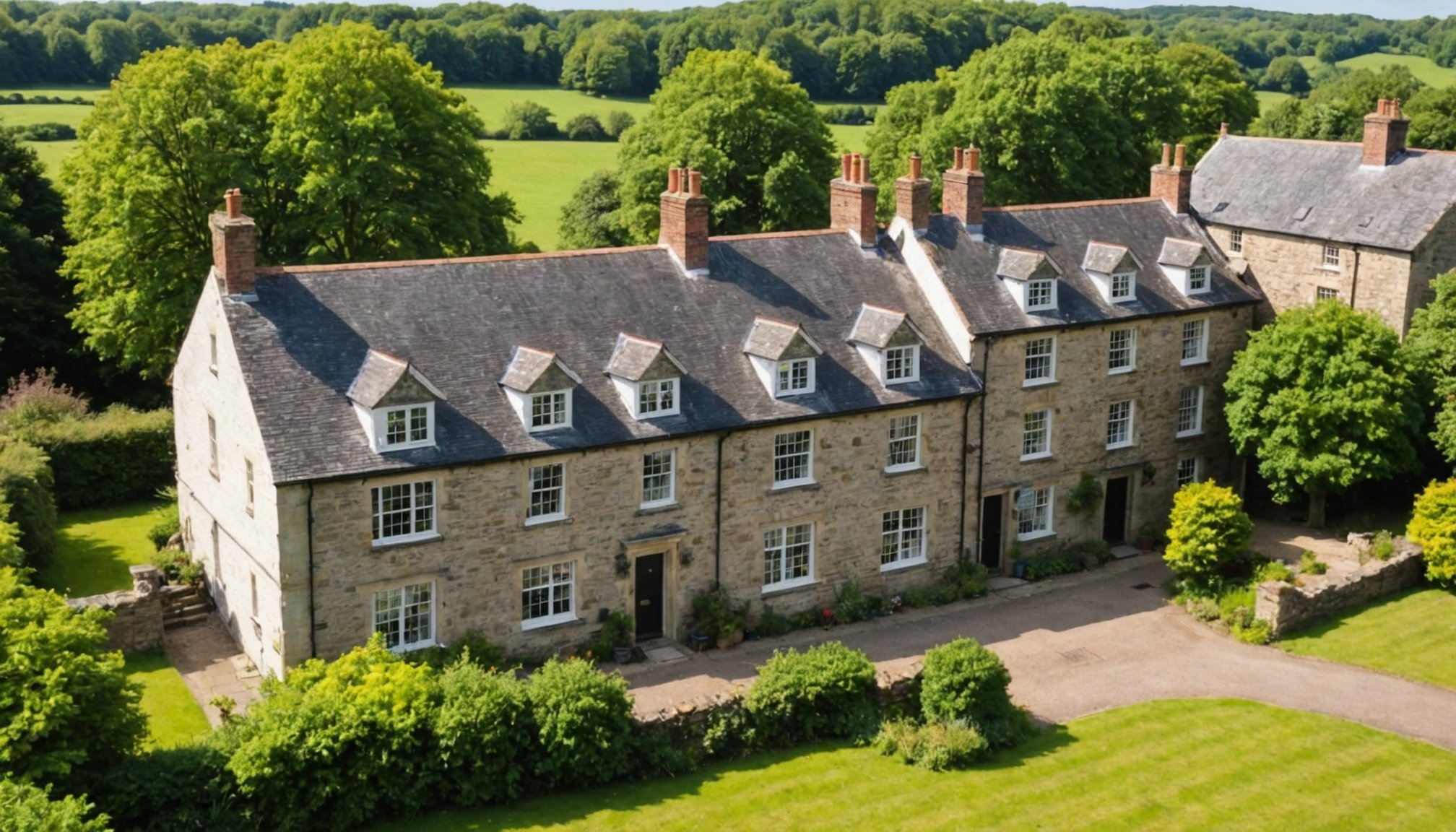Understanding Grade II Listed Properties
Grade II listed properties hold a unique spot in the realm of heritage protection and preservation efforts. In the United Kingdom, properties classified under Grade II are often those of special interest, warranting every effort to preserve them. This classification is indicative of a building’s historical significance and is specifically intended to safeguard architectural and cultural heritage.
What Makes a Property Grade II Listed?
Properties achieve a Grade II status due to their historical, architectural, or cultural importance. The listing acts as a marker from heritage authorities, ensuring the maintenance of the property’s character and preventing any unjust alterations. Regulations prohibit significant modifications to these properties without authorisation. Owners are responsible for maintaining the historical integrity while adhering to regulations that manage structure rehabilitations and aesthetic adjustments.
Additional reading : Essential Insurance Insights for Properties Next to York”s Historic Landmarks
Why is Heritage Preservation Vital in Wales?
Heritage preservation in Wales extends beyond safeguarding history; it encompasses maintaining local identity and community roots. Grade II listings play a crucial role here by protecting structures that signify Wales’ culturally rich past. Efforts in this realm ensure future generations witness and understand the architectural and historical narratives woven into Wales’ landscapes. Such safeguarding practices also bolster tourism and local economies by promoting enhanced cultural engagement.
Key Insurance Considerations for Grade II Listed Properties
When considering insurance considerations for Grade II listed properties, it’s crucial to address their unique risks. These properties often possess distinctive architectural features that require specialised preservation techniques, making potential repairs more complex and costly. As such, understanding the specific risks associated with listed properties is essential for ensuring adequate property protection.
Also read : Key Influences on Securing Construction Loans for Waterfront Properties in the UK
There are several insurance types suitable for listed properties, each tailored to meet the nuanced needs of these historical buildings. Buildings insurance is undoubtedly necessary, covering damages to the structure itself. Additionally, contents insurance can protect valuable interiors. More specialised policies, such as indemnity insurance, might be required if there are breaches of any building regulations—a common concern with older structures.
Furthermore, it’s vital to secure insurance for the full replacement value of the property. This ensures that in the event of significant damage or total loss, the complete restoration of the building to its original state is financially viable. Proper valuation is key, as underestimating restoration costs may lead to inadequate coverage, leaving property owners financially vulnerable. Understanding these insurance considerations is integral for safeguarding the integrity and value of Grade II listed properties.
Regulatory Framework and Legal Obligations
Understanding the regulatory framework and your legal obligations is crucial when dealing with listed properties. These properties are safeguarded by statutory protections, ensuring that their historical and architectural significance is preserved. Owners must be aware of this special status, as any modifications to a listed building generally require planning permission.
Statutory Protections for Listed Properties
Listed properties fall under strict statutory protections. Owners can’t initiate changes without compliance to these regulations, making it essential to consult local authorities early in a project. Modifications or demolitions, even minor adjustments, might necessitate thorough approval processes.
Planning Permission Requirements
When planning any modification, understanding planning permission requirements is paramount. This isn’t merely a formality; it’s a critical legal obligation that impacts project timelines directly. Engaging with professionals experienced in the regulatory framework can expedite approval processes and ensure adherence to legal standards.
Consequences of Non-compliance
Ignoring the regulatory framework and bypassing planning permissions can lead to severe consequences. Owners might face hefty fines, enforced restoration to original conditions, or even legal action. Reputational damage is also a risk, stressing the importance of compliance. Ultimately, prioritising legal obligations benefits the preservation of the property’s cultural value.
Selecting the Right Insurance Provider
Choosing between various insurance providers can be overwhelming. Understanding selection criteria tailored to your needs is crucial in making an informed decision.
Evaluating Insurer Experience with Listed Properties
When it comes to insurance providers, their experience with listed or heritage properties is pivotal. Such properties often require bespoke coverage due to their unique conservation needs. Working with reputable insurers who have a proven track record in this domain ensures you get the protections tailored specifically to these historical properties. Experience translates to the ability to assess risks accurately and offer valuable advice on necessary coverages.
Key Factors in Choosing an Insurer
In selecting an insurer, evaluate various selection criteria:
- Financial stability: It’s imperative to ensure that the insurer has the resources to honour claims, especially during widespread disasters.
- Claims handling reputation: Efficient processing ensures customers receive timely support.
- Customized coverage: Ensures the policy caters to the specific needs of your property.
Importance of Customer Reviews and Ratings
Customer reviews and ratings are invaluable when selecting an insurer. They offer insights from current policyholders about real-world experiences. Look for feedback on claims processing, customer service, and the insurer’s adaptability to the needs of listed properties. Such reviews can guide you toward reputable insurers with a strong focus on customer satisfaction and financial reliability.
Common Coverage Gaps and How to Avoid Them
Understanding coverage gaps is crucial in safeguarding oneself against unforeseen situations. Many standard insurance policies contain exclusions that can leave policyholders vulnerable. Common exclusions often include wear and tear, intentional damage, and certain natural disasters. Recognising these exclusions allows individuals to assess their current policies for any insurance limits that could leave them underinsured.
Homeowners may not realise that renovations can create a considerable gap in their coverage. It’s essential to evaluate whether additional insurance is needed during significant home improvements. This ensures adequate protection against any liabilities that may arise from construction work or increased property value.
To avoid coverage gaps, consider strategies like purchasing add-on policies or endorsements. Some insurers offer riders that extend protection for specific scenarios beyond the usual scope. For example, flood insurance is not generally included in standard home policies, necessitating an additional purchase for those in flood-prone areas.
By proactively examining their current coverage and the exclusions it contains, individuals are better equipped to pursue options that guarantee comprehensive protection. Updating insurance as life circumstances change helps avoid gaps and maintains the necessary protection level for one’s evolving needs.
Tips for Filing Claims on Listed Properties
Filing a claim on a listed property requires an understanding of the claims process and meticulous preparation. The first step is to thoroughly document any damage. This requires capturing detailed photographs and keeping a record of all communication with insurance providers. This way, you create a visual timeline, showcasing the extent and impact of the damage over time.
When filing insurance claims, ensure to include detailed, accurate descriptions of the damage in your reports. This information aids the insurer in understanding the situation from your perspective. Organise your documentation by categorising photographs, receipts, and any repair estimates. This level of preparation underscores the seriousness of your claim.
Effective communication with your insurer is crucial. Use clear, direct language and complete any required forms promptly to avoid causing delays in your claim processing. When contacting your insurance company, ask direct questions like: “What additional documentation is required?” or “How can I expedite my claims process?” Taking these steps improves transparency and efficiency.
Lastly, know your policy inside out. Frequently, misunderstandings arise due to unfamiliarity with specific coverage terms. Ensure you understand the policy specifics, which helps set realistic expectations throughout the filing insurance claims process. This proactive approach simplifies the entire experience, making it less daunting and more manageable.
Case Studies and Real-Life Examples
When examining insurance success stories, certain case studies of Grade II properties reveal successful navigation of complex claims. For instance, a Grade II listed building owner faced potential structural damage due to age-related wear. Engaging a proactive approach to risk management, they collaborated with specialised insurers who understood the intricacies of heritage properties. Consequently, the claim was meticulously documented, embracing both the historical significance and current condition of the building. This led to a streamlined process and full restitution, showcasing the importance of engaging insurers with expertise in such niche sectors.
Lessons Learned from Mismanaged Insurance Situations
In contrast, some property owners have encountered challenges due to mismanaged claims. Take the example of owners who underestimated the coverage needs for their historic buildings, leading to inadequate claims during unforeseen incidents. Key lessons here emphasize the need for comprehensive insurance policies that consider all potential risks. This underscores the significance of aligning insurance strategies with the unique attributes and vulnerabilities inherent to Grade II properties.
Highlighting Best Practices in Insurance Approach
Adopting best practices in risk management involves:
- Conducting thorough evaluations of property conditions
- Selecting insurers with specialised knowledge
- Understanding policy terms and conditions
- Constantly reassessing and updating coverage to match evolving risks
Resources and Further Reading
To navigate the intricacies of insurance effectively, it is crucial to equip oneself with a well-rounded understanding. This section offers additional resources to assist in expanding your knowledge and making informed decisions.
A comprehensive list of suggested insurance guides and websites can be immensely helpful. Websites specializing in insurance offer pivotal insights and updates which are crucial in staying updated with the changing landscape. For instance, authoritative guides on household, health, and automotive insurance can offer clarity and direction.
Contact information for relevant local insurance authorities and organizations should not be overlooked. Such connections can provide direct support and clarify legislative queries you may have. Checking these resources can enable you to compare insurance policies more effectively and secure the best options available.
The importance of ongoing research when dealing with insurance cannot be overstated. Frequently reviewing helpful links and keeping abreast of industry changes ensures you are never left in the dark. This diligence aids in consistently honing your understanding and can safeguard against potential pitfalls.
Remember, exploring multiple perspectives and continuously seeking out additional resources empowers you to make well-informed decisions in the complex world of insurance.











